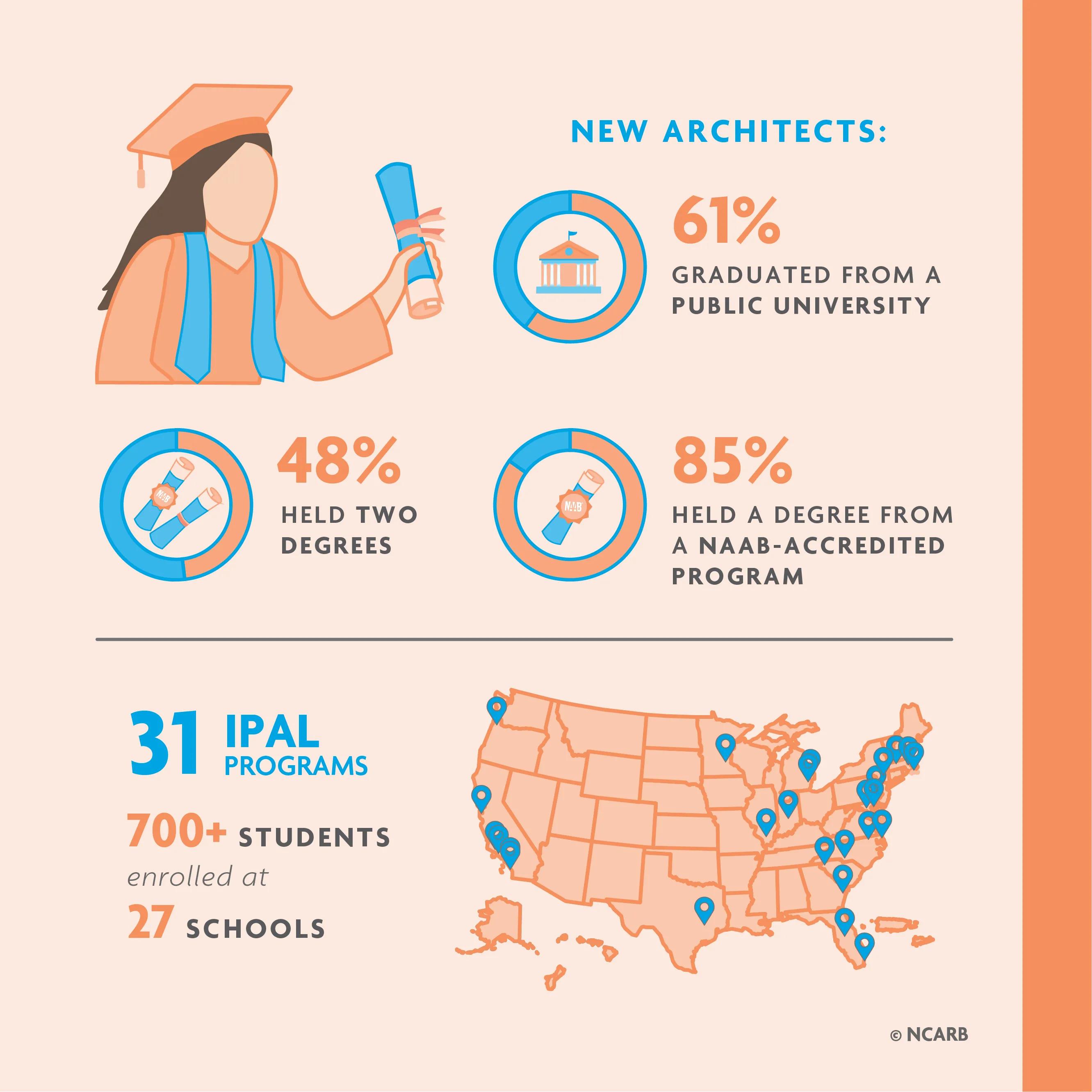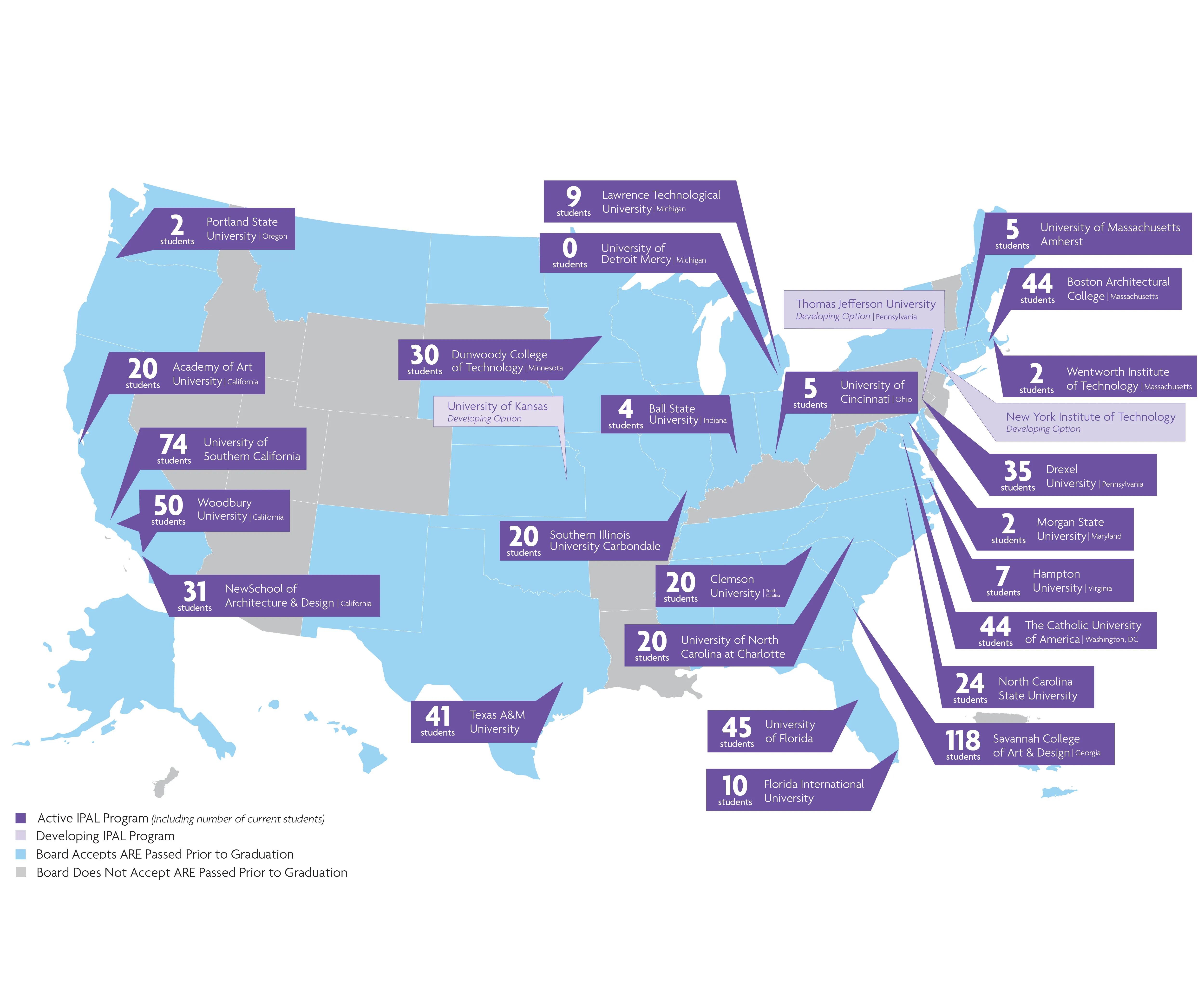
Earning a degree from an architecture program accredited by the National Architectural Accrediting Board (NAAB) is the most common path for candidates seeking architectural licensure in the United States. Data continues to show that, on average, licensure candidates with a degree from a NAAB-accredited program have greater success when taking the national licensing exam.

In 2022, most new architects graduated from public universities, with 10 schools educating nearly 25% of all new architects in 2022. The proportion of new architects with just one degree is increasing, although most Record holders have both a degree from a non-accredited program and a degree from a NAAB-accredited program.
Interest in the Integrated Path to Architectural Licensure (IPAL) continues, with over 700 students enrolled in IPAL options across the country during the 2021-2022 school year.
NAAB data shows that over 9,200 new students enrolled in a NAAB-accredited program in the 2021-2022 school year—a 13% increase from the previous school year. Of the new students, 47% are enrolled in Bachelor of Architecture programs, and 53% are enrolled in Master of Architecture or Doctor of Architecture programs.
Just over half of new students are women (53 percent), 2 percentage points higher than the previous school year. This suggests that NCARB may see greater gender representation on the licensure path in the years to come.
Note: This data is provided to the NAAB by accredited programs and will be published in the 2022 NAAB Report on Accreditation in Architecture, available at www.naab.org. Students enrolled in non-accredited architecture programs are not represented.
Nearly 30,000 students were enrolled in a NAAB-accredited program in the 2021-2022 school year, an increase of 7% compared to the previous academic year. This is the fifth consecutive year of steady increases.
Of these students, 60% are enrolled in Bachelor of Architecture programs and 40% are enrolled in Master of Architecture or Doctor of Architecture programs. Forty-seven percent are men, and 53% are women.
Note: This data is provided to the NAAB by accredited programs and will be published in the 2022 NAAB Report on Accreditation in Architecture, available at www.naab.org. Students enrolled in non-accredited architecture programs are not represented.
Nearly 6,500 degrees were awarded by NAAB-accredited programs across the country in 2022, a 3% increase compared to the previous school year. Of these graduates, 49% were men and 51% were women—the same proportion seen in 2021.
Note: This data is provided to the NAAB by accredited programs and will be published in the 2022 NAAB Report on Accreditation in Architecture, available at www.naab.org. Students enrolled in non-accredited architecture programs are not represented.
After several years of gradual increases, the proportion of new architects without a degree from a NAAB-accredited program fell by 3 percentage points in 2022. Eighty-five percent of new architects in 2022 held a degree from a NAAB-accredited program.
Out of the 55 U.S. jurisdictions, only 17 will license individuals who don’t hold a degree from a NAAB-accredited program (typically by substituting additional experience in lieu of a professional degree).
Graduates of NAAB-accredited programs perform significantly better on the ARE compared to their peers who did not graduate from a NAAB-accredited program. In 2022, graduates of NAAB-accredited programs had an overall exam pass rate of 57%, compared to 48% for graduates of non-accredited programs—a 9 percentage point difference.
The average overall ARE pass rate for all candidates in 2022 was 55%.
In 2022, 61% of new architects graduated from a public university, and 40% graduated from a private university. The proportion of new architects who hold a degree from a public university has held relatively steady since 2018.
Ten schools produced nearly a quarter of new architects in 2022. Just over 3% of all new architects in 2022 graduated from Virginia Tech, and 3% graduated from California Polytechnic State University. These two schools have consistently been the top two sources of new architects over the past five years.
Of new architects in 2022, 47% held just one degree—up 4 percentage points from 2021. A near-equal proportion (48%) held two degrees, compared to 52% in 2021. Of the remaining new architects, 1% held no degree, and 4% held three degrees.
Sixty-two percent of new Asian architects in 2022 held more than one degree—the highest proportion of all racial and ethnic groups. At 52%, new Hispanic or Latino architects had the highest proportion of individuals with just one degree—but also the highest proportion with three degrees (6%).
Fifty-five percent of new female architects in 2022 held more than one degree, compared to 50% of new male architects. Of new male architects, 1% had no degree, 49% had one degree, 46% had two degrees, and 4% had three or more. By comparison, less than 1% of new female architects held no degree, 45% had one degree, 51% had two, and 4% had three or more.
When a Record holder has finished their education, they can add their transcript to their NCARB Record and have their degree verified by NCARB. Of Black or African American Record holders who had their education verified in 2022, 84% held at least one degree from a NAAB-accredited program—including 53% who held both a degree from a NAAB-accredited program and from a non-accredited program.
Hispanic or Latino Record holders were the least likely to hold a degree from a NAAB-accredited program at 74%.
Of female Record holders who had their education verified in 2022, 82% held at least one degree from a NAAB-accredited program, including 54% who held both a degree from a NAAB-accredited program and from a non-accredited program. Comparatively, 80% of male Record holders held at least one degree from a NAAB-accredited program.

There are currently 31 NAAB-accredited programs at 27 colleges participating in NCARB’s Integrated Path to Architectural Licensure (IPAL) initiative, which launched in 2015.
The IPAL option—offered as an additional path within an existing NAAB-accredited program—seeks to shorten the time it takes to become an architect for students dedicated to earning a license. Participating programs provide students with the opportunity to complete the AXP and take all six ARE 5.0 divisions prior to graduation.
During the 2021-2022 school year, over 700 students were enrolled in IPAL options across the United States. Over two-thirds (38) of NCARB’s 55 U.S. jurisdictions will accept divisions of the exam passed while participating in an IPAL option.
Note: Enrollment data is from the 2021-2022 school year. Some accepted programs are still developing their IPAL options.
